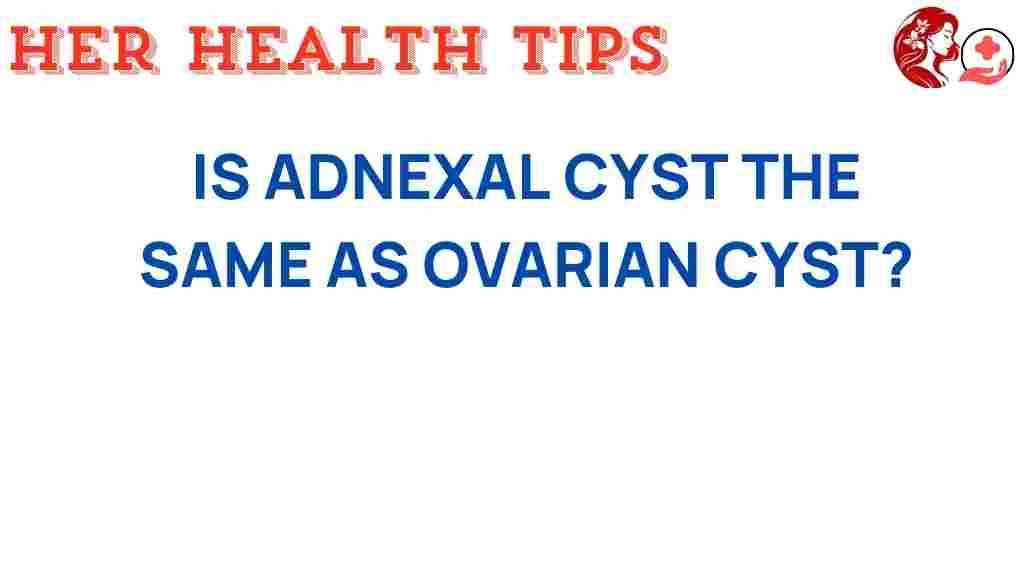Unraveling the Mystery: Are Adnexal Cysts Just Ovarian Cysts in Disguise?
When it comes to women’s health, understanding the various types of cysts is crucial for maintaining reproductive health. Among the most common types are adnexal cysts and ovarian cysts. Many individuals often wonder: are adnexal cysts just ovarian cysts in disguise? In this article, we will delve into the definitions, symptoms, diagnosis, and treatment of both adnexal and ovarian cysts, helping to clarify their differences and significance in gynecological conditions.
What is an Adnexal Cyst?
An adnexal cyst refers to a cyst located in the adnexa of the uterus, which includes the ovaries, fallopian tubes, and surrounding tissues. Adnexal cysts can be formed from various tissues and may contain fluid, tissue, or even blood. They are not limited to the ovaries, which distinguishes them from ovarian cysts.
Understanding Ovarian Cysts
Ovarian cysts are fluid-filled sacs that develop on the ovaries. They are quite common and can occur during a woman’s menstrual cycle. Most ovarian cysts are benign and often resolve on their own without the need for treatment. However, certain types of ovarian cysts can lead to complications or may require medical attention.
Types of Ovarian Cysts
- Functional Cysts: These are the most common type and include follicular cysts and corpus luteum cysts.
- Dermoid Cysts: These contain various types of tissues, such as hair, skin, or teeth.
- Cystadenomas: These develop from ovarian tissue and can be filled with a watery or mucous substance.
- Endometriomas: Associated with endometriosis, these cysts are filled with old blood and can be painful.
Symptoms of Adnexal and Ovarian Cysts
While many cysts are asymptomatic, some women may experience symptoms that can affect their daily lives. Common cyst symptoms include:
- Pelvic pain or discomfort
- Abdominal bloating
- Irregular menstrual cycles
- Difficulty emptying the bladder
- Changes in bowel habits
It is important to note that symptoms can vary depending on the type of cyst and whether it has ruptured or caused complications. If you experience severe pain or other concerning symptoms, it is crucial to seek medical attention.
Diagnosis of Adnexal and Ovarian Cysts
Diagnosing adnexal and ovarian cysts typically involves a combination of the following:
- Medical History: Discussing symptoms and menstrual history with your healthcare provider.
- Physical Examination: A pelvic exam may reveal tenderness or the presence of a mass.
- Imaging Tests: Ultrasound is the most common imaging technique used to visualize cysts. In some cases, a CT scan or MRI may be needed for further evaluation.
- Blood Tests: Hormonal levels and tumor markers may be checked to rule out more serious conditions.
When to Seek Medical Attention
If you experience any of the following red flag symptoms, it is essential to contact your healthcare provider:
- Severe or sudden pelvic pain
- Fever or vomiting
- Signs of shock (rapid breathing, weakness, confusion)
- Heavy vaginal bleeding
Treatment Options for Adnexal and Ovarian Cysts
The treatment for adnexal and ovarian cysts depends on several factors, including the type of cyst, symptoms, and whether it is causing any complications.
Observation
In many cases, especially for functional cysts, a “watchful waiting” approach is recommended. Your healthcare provider may suggest:
- Regular follow-up appointments
- Repeat ultrasounds to monitor the cyst
- Tracking symptoms over time
Medications
If cysts cause discomfort, medications may be prescribed to alleviate symptoms:
- Hormonal Birth Control: Helps regulate menstrual cycles and can prevent the formation of new cysts.
- Pain Relievers: Over-the-counter pain medications can help manage mild to moderate pain.
Surgery
In cases where cysts are large, persistent, or causing significant symptoms, surgical intervention may be necessary. Surgical options include:
- Laparoscopy: A minimally invasive procedure that allows the surgeon to remove the cyst through small incisions.
- Laparotomy: A more extensive surgical approach that may be required for larger cysts or if cancer is suspected.
Preventive Measures and Lifestyle Changes
While not all cysts can be prevented, certain lifestyle changes may reduce the risk of developing cysts:
- Regular Check-Ups: Routine gynecological exams can help detect cysts early.
- Healthy Diet: A balanced diet rich in fruits, vegetables, and whole grains can support overall reproductive health.
- Exercise: Regular physical activity can help maintain a healthy weight and balance hormones.
- Stress Management: Techniques such as yoga, meditation, and deep breathing can reduce stress levels.
Troubleshooting Common Concerns
If you suspect you have an adnexal or ovarian cyst, consider the following troubleshooting tips:
- Keep a Symptom Diary: Document any symptoms, their timing, and severity to provide detailed information to your healthcare provider.
- Research and Educate Yourself: Understanding cysts can help you feel more empowered during medical visits.
- Communicate Openly: Discuss all your concerns and ask questions during your appointments to ensure comprehensive care.
Conclusion
In summary, while adnexal cysts and ovarian cysts share similarities, they are not the same. Understanding the differences is crucial for women’s health and effective management of gynecological conditions. If you experience symptoms or have concerns about cysts, consult with your healthcare provider for proper diagnosis and treatment options. Remember, maintaining reproductive health involves regular check-ups and a proactive approach to managing your health. For additional resources and information about women’s health, visit Women’s Health Foundation.
This article is in the category Reproductive and created by HerHealthTips Team
